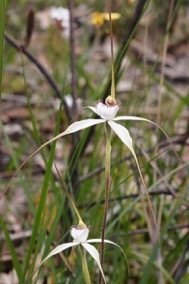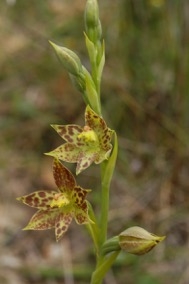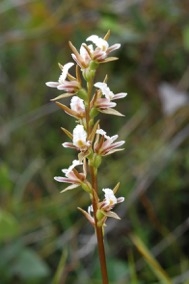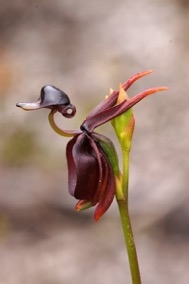Our accolade for the month of October goes to two of our Spider Orchids, the Large White Spider Orchid, Caladenia venusta, and the Mantis Orchid, C. tentaculata.

Large White Spider Orchid
C. venusta often puts on spectacular flowering displays following fire, but this year it has flowered prolifically throughout the district without fire stimulation. At this stage it has just about finished flowering and is setting seed, while C. tentaculata is also having a wonderful season and is in full bloom throughout the heathlands, woodlands and open forest.

Mantis Orchid
The green and crimson flowers held on a hairy stem to 40cm high have a large white labellum with green marginal teeth rising above the column, and have a deep maroon tip on the end of the labellum.
To those orchid enthusiasts who wait each year to admire our wealth of Sun orchids, the Thelymitra species, they do apologise for their lack of flowering this year. Most species have appeared in large numbers, but you would be very fortunate if you saw them open – it was just too cold and wet. The majority didn’t open but have obviously self-pollinated with the ovaries swollen as the seed develops. I did manage to see a number of species flowering on Saturday, October 29, the day after I returned from my overseas holiday, but it was a short-lived experience.
There is still one species of Sun Orchid that is worth looking for – I have seen a few nice specimens in mid- November. That is the rare Blotched Sun Orchid, Thelymitra benthamiana. It has a wide, veined, bright green leaf, the flower stem grows to about 30cm tall and bears up to 5 greenish-yellow flowers with brown spots and blotches. The yellow column arms are deeply fringed.

Blotched Sun Orchid
Despite the lack of Sun Orchids there are many other terrestrial orchids to see – Onion Orchids, Microtis species, are flowering in great numbers and Leek Orchids, Prasophyllum odoratum, are bearing some great flowering stems.

Leek Orchid
Eastern Bronze Caladenias, Caladenia transitoria, are flowering well though you may have to look hard to notice them.

Eastern Bronze Caladenia
And of course we can’t end our orchid notes without mentioning the eye-catching Flying Duck Orchid, Caleana major. Although not in large colonies this year there are some beautiful specimens in flower.

Flying Duck Orchid
Remember that photos and descriptions of all our orchids are found in Orchids of the Anglesea District available from Angair. Please let us know of your orchid discoveries. They do help to draw up a larger picture of the wealth of terrestrial orchids in the Anglesea district – an area of international significance.
Margaret MacDonald